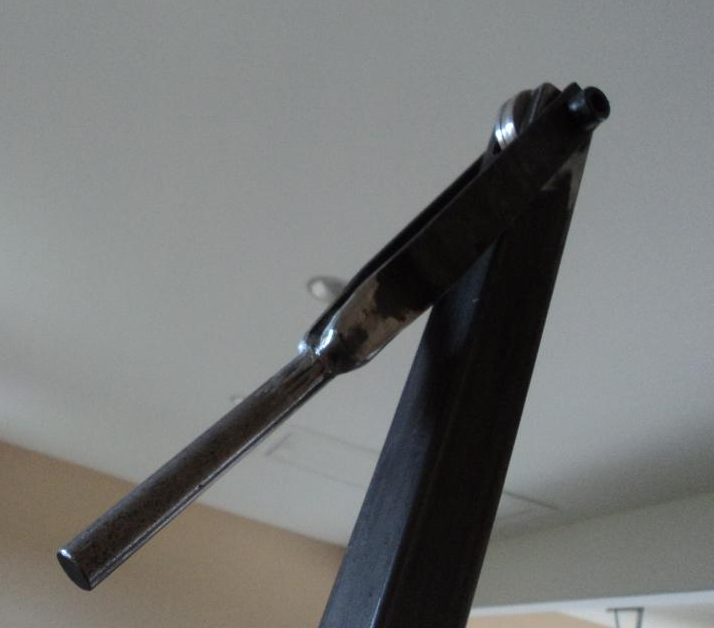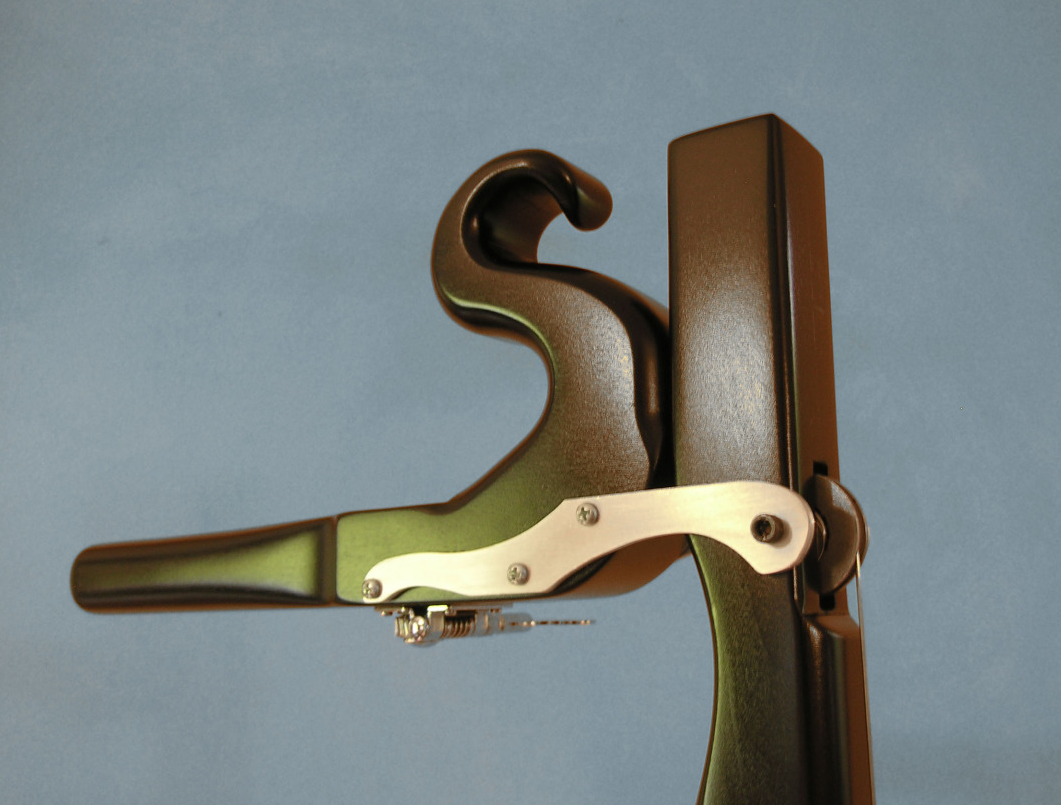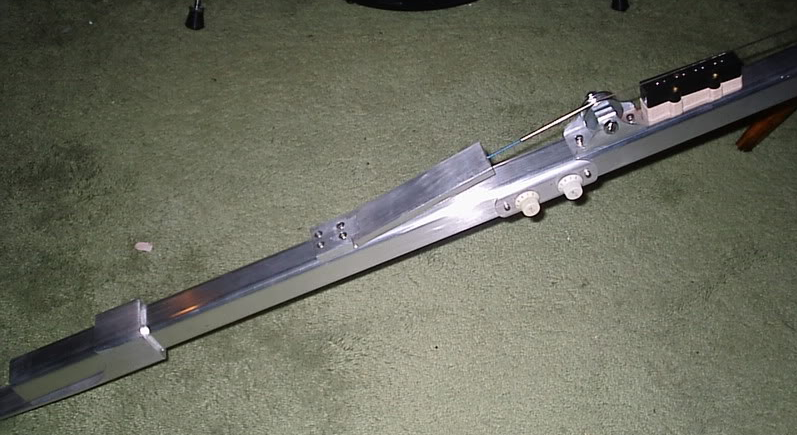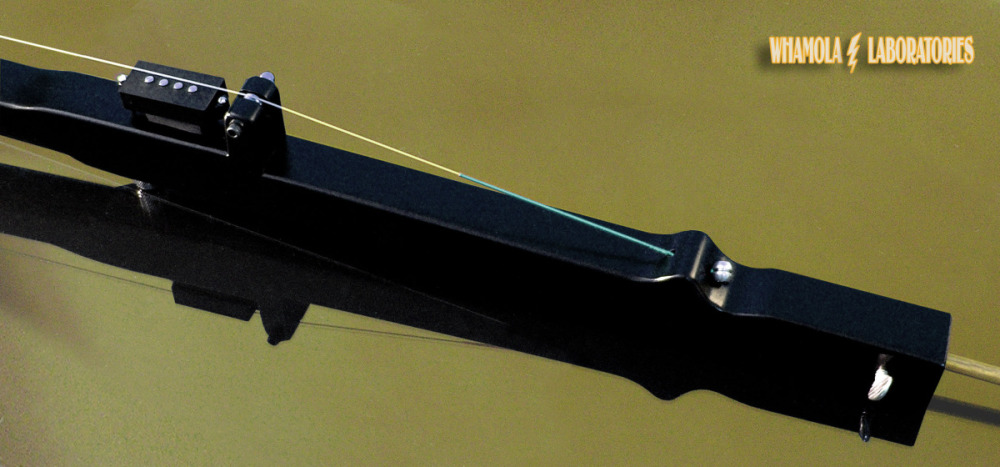/projects/whamola

A whamola by
Whamola
Laboratories
For those of you who don’t know, a whamola is an instrument made famous mostly by the bass guitarist/singer Les Claypool from the band Primus. The Whamola typically has a long and relatively thin body made of wood or metal and a single bass (electric or upright) string running along the body. The string is attached to a whammy-arm in the top end of the body. Sound is generated by hitting the string with a drum stick and changing the pitch by pulling on the arm. Often whamolas also have a fretless fingerboard, which allows them to be played like a normal bass guitar. In short: It’s a one-string bass guitar with a big whammy arm and played with a drumstick.
I first heard about this lovely device from my brother who played me the song Whamola by Les Claypool's Fearless Flying Frog Brigade found on the album Purple Onion. Since the whamola is not a very mainstream instrument, most whamolas are made by their users themselves. Since it looked interesting and I was sure I’ll never be able to try it if I don’t build one myself, I decided to take on a personal challenge to construct a Whamola of my own.
This page was written for two purposes:
- Keep a diary just so that I can remember what it was like to build it. Or if I get angry with it and throw it away, to remember that I build it in the first place.
- Help other people interested in building whamolas get some ideas and maybe save them the time I spent Googling pointlessly around.
Table of contents
list of things to consider
A quick Google search will provide you with an endless list of whamola designs. Where are almost as many different whamolas around as there are whamolas. When designing your own whamola, here is a checklist of things you should think about:- Body: Typically the body is made of wood or metal. I think wood looks nicer, and it’s easier to work on if you want something fancy. Although, for a quick’n’dirty version I would go with metal, since it’s cheaper and the whamola can be built by using just a drill and hacksaw. Which material to use also depends on what kind of tools you have lying around.
When using wood, most constructors recommend a harder type of wood, such as oak. A harder wood not only handles the tension better, but it is also doesn’t chip as easily during the construction.
How think the whamola should be depends on many factors, but you should at least consider that you should be able to grab around the whamola, especially if you choose to build a fingerboard. The electronics also need quite a lot of space. Note, that the whamola doesn’t need to have the same thinkness along its length. A thick enough piece of wood might be hard to find, but you can also buy two smaller pieces and glue them together.
Another important factor is how long the body will be. Typically whamolas are around the same height as their players, although most whamolas have an endpin that reduces the length of the actual body. The length between the nut and bridge depends on which strings are used. My tip is to take measures from an existing electric or upright bass.
A metal body whamola with
metal whammy-arm. - Strings: If the bridges are less than 90 cm apart, strings from normal electric basses can be used. Strings from upright basses allow this distance to be longer, but the strings are more expensive. Longer strings have a lower tone and some whamola constructors seem to think longer strings are better, but I guess it’s a matter of taste.
- Pulley: The string runs along the body from the bottom up and bends to the whammy-arm on a pulley wheel. The wheel can be whatever material, but at least for me the biggest problem was finding one. The closest ready-made wheel was from a maritime shop, but they were so expensive I decided to build one myself.
- Whammy-arm: Usually the arm is a piece of wood or metal and it’s attached to the same axis as the pulley. Most whamolas have the arm attached with metal plates on the side of the whamola. With this type of attachment the range of movement is very good.
There are numerous other methods on attaching the arm. For example, you can use a hinge on the back of the body. Some whamola builders have reported that in some cases the arm will pop strings easily if the arm tightens the string in a wrong direction.
One nice feature is to have the possibility to lock the whammy in a certain position. Normally this means that the arm is designed so that it will stop at the horizontal level. This allows the whamola to be played using the fingerboard. - Nut: Some whamolas don’t have a separate nut, but instead the pulley acts as a nut. The nut can also be constructed from wood, metal, plastic, bone or other materials nuts are typically made of.
- Fingerboard: The fingerboard can be made of a separate piece of wood or carved out of the body. Separate fingerboards are often made of some hard wood. You can also use standard fingerboards for electric and upright basses. I recommend choosing wood that looks nice since it covers a big part of the instrument. An ugly or dull fingerboard will result in an ugly and dull whamola.
Not all whamolas have a fingerboard. Especially, if the whammy arm doesn’t lock into place, playing with the fingerboard is impossible as you have only two hands. - Bridge: There are several options for the bridge. It can be made by hand out of wood or metal. Also parts from basses can be used. Some whamola constructors have build a similar pulley wheel as the used in the arm.
The bridge should be build slightly higher than on a normal bass guitar, since the string will vibrate with a higher amplitude because instead of picking, it is hit with a drum stick. The length of the whamola also effects how much the sting will vibrate. - Electronics: Whamolas normally use standard electronic bass pickups. Most constructors prefer single coil pickups since they have a brigher and in some sense more distorted sound, but also several whamolas with humbuckers can be found. The most popular setups are probably the ones that have either a Fender Jazz Bass pickup or one of the two pickups of a Fender Precision Bass. Other models are often too wide for the narrow body of a whamola.
Another alternative is to coil your own pickups. Because the whamola has only one string, the pickup can be made of just one magnet. This way you can also affect the sound of the whamola more.
In addition to the pickup you will also need a jack to connect a cable. Optionally you can add a volume and/or tone knobs. - Tuning peg: Typically the tuning peg is attached to the whammy-arm. It can also be attached to the lower end of the body, but then special arrangements may be needed to keep the string from jumping off the bridge. Also, because the way the pegs are meant to be attached to a headstock, the body might be too think.
Note, that even if the whamola is not used as a tuned instrument, almost every whamola a tuning peg, because otherwise the string might hard to fasten. - Endpin: A nice addition to the whamola is an endpin at the lower end of the body. The pin can be adjustable to allow players with different sizes. You can get endpins for a cello or upright bass from music stores, but you can also build one from a metal rod.

A whammy-arm that locks
to a horizontal level.

Pulley bridge and Jazz Bass
electronics.

Wooden bridge and Precision
Bass electronics.
my whamola
I chose to build my whamola out of wood. I didn't have that many tools available, so the goal was to construct the whamola using mostly the few ones I had.
The body is made from oak. Two-by-two surfaced oak was not as easy to come by, so I decided to glue two 21x45 mm boards together. At first, this turned out to be a good idea, since carving the space required by the electronics and pulley was now easier. A bit later, I realized that this made the body very thick and it made the whamola not as easy to play as I hoped. I also got a 10x45 mm board of oak for the fingerboard. The fingerboard is glued on to the body. Like the body, the fingerboard could also have been a bit thinner to make playing easier.
The length of the whamola is 180 cm including the 60 cm long endpin. The endpin can be retracted to about 30 cm for shorter players. Also, the endpin can be removed completely by loosening an ear nut at the bottom. This way storage is a lot easier. The distance between the nut and bridge is around 90 cm. With the 90 cm string span I can use normal size bass strings instead of expensive upright strings. The length of the string is also adjustable with the bridge piece, although in practice this is mainly just a neat visual detail. The whamola is definately not a precise instrument, and it cannot be tuned like a guitar. Any tuning is lost immediately after using the whammy arm.
The handle is made of the same wood as the fingerboard. The end is shaped thinner to make the grip fit a hand. In addition to the handle the whammy arm has a hole for the tuning peg and the stopper wedge to stop the whammy to a horizontal level. This way the whamola can be played with the fingerboard.
One of the most difficult pieces to find turned out to be the tuning peg. They are always sold in sets of 4 or 5. Luckily I was able to find one in a miscellaneous box at the local guitar parts shop. If you're building a whamola yourself, I recommend thinking how to mount the peg correctly. Normal pegs will require the material to be about 10 mm thick. Much thinker boards will not work and much thinner boards might break under the tension. Carving slots or inlays for the peg could be an answer, but without any proper tools, a simpler solution had to suffice.
I will post pictures and more details about the construction later. For now, I hope this page will provide you with some information. Feel free to contact me if you have something to ask about the whamola.
test run
<TODO>
- How is the sound?
- How does it feel?
- Is it cool or what!
how to play
First, playing the whamola is hard. If you are used to playing guitars of bases, you might think that aiming the pitch is simple: "just pull the whammy!". But, sadly no. It takes a while to get used to the the whammy arm. The funny part is that as soon as you do, the tuning is way off and you have to start everything from the beginning.
An important thing to remember is that the whamola is mainly a rythm instrument. If you listen to Les Claypool, you notice that he plays the whamola more like the drums, not a bass guitar. Just like with playing drums, playing the whamola alone might seem pretty dull. I strongly recommend practicing with your band, at least if they are not too hostile towards your new instrument.
So far I haven't played the whamola too much. Later, I promise I will write a more complete section on how to play the whamola, but currently I don't have enough experience to do so. If you have any tips you wish to share, please do!